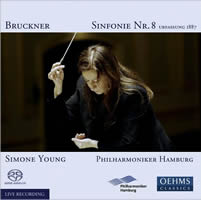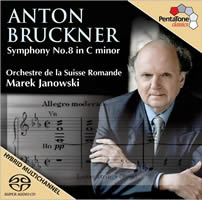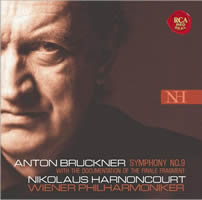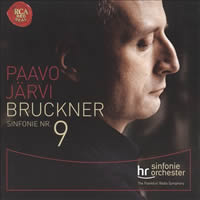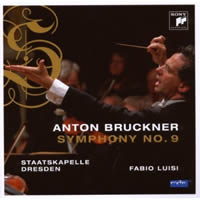Eights and Nines
|
Dan Albertson [January 2011.] [Here is more proof of my unnatural kinship with St. Anton. Thank you, Thành Lu, for the charm, the Charm, the worldly ways, and always being correct (damn it!); Arvey Basa, for the smooth transition to iridescent insouciance; Adam Dubin, for the glorious bond and lascivious manifest; Julio Beltrán, for the outrageous solicitations; Kim Jackson, for the effortless jocularity; Minoru Ueda, for the major and the minor; Sid Samberg, for the lithe rejuvenation; and Chen Yao, for an infinity of Spannungen. A good work has been wrought upon me by this octet — and I know it. D.A.]
Anton BRUCKNER: Symphony No. 8 in C minor (1884-87 version). Philharmoniker Hamburg, Simone Young (cond.). OehmsClassics OC 638 (2 SACD hybrid CDs) (http://www.oehmsclassics.de/). Distributed in the US by Naxos (http://www.naxos.com/). Two live performances, ably documenting a musical curiosity. More good news from the Hamburg cycle: Disciplined, vibrant playing, making the case for the “original.” For once, the Brüder Schalk were helpful interference. Here, I closes in banality without diminution; the fusillade of six cymbal crashes in III is tawdry; and the closing pages of the score lose sympathy with less string writing. Young has a slow, thoughtful pace and brings balance and cohesion difficult to muster in this feral edition of the score. Applause is omitted, but rustling is not. Engaging notes by Michael Lewin further enhance the experience. A few references to “1878” instead of “1887” are not worrisome. His vacillation on the symphony is suspect. Of changes to the first movement, what he writes could easily apply to the totality: “Whether that is always of benefit to the whole is an open question.…” In a volte-face, he writes later, “… the version of 1887 does not represent the first draft of a later masterpiece; it IS the masterpiece.…” Who among us would agree? I reject this version as a whole, yet admire the rendition. A tad less than 83 mins., it would have fit on a single disc, but OehmsClassics insists on two SACDs instead.
Anton BRUCKNER: Symphony No. 8 in C minor (1890 version, ed. by Leopold Nowak). Orchestre de la Suisse Romande, Marek Janowski (cond.). Pentatone Classics 5186 371 (SACD hybrid CD) (http://www.pentatonemusic.com/). Distributed in the US by Naxos (http://www.naxos.com/). A major disappointment. The orchestra has no Brucknerian pedigree and the maestro is not particularly distinguished in any repertory, yet any new reading of 8 raises my hopes. Janowski dashes them on the first page with a hesitant entry on low strings, proceeding to yank the tempo wildly. Some embarrassing, off-kilter pizzicati near the end of I set up its final bars being played indifferently. The OSR improves during II and III, in which the three harps are audible, a presence worth praising. IV makes no impression at all, making me wonder why three recording sessions yielded such paltry results. Bruckner: Symphony No. 8
Anton BRUCKNER: Symphony No. 9 in D minor (1887-96) (ed. by Benjamin Gunnar Cohrs, with the documentation of the finale fragment, ed. by John A. Phillips). Wiener Philharmoniker, Nikolaus Harnoncourt (cond.). RCA Red Seal 82876 54332 2 (2 SACD hybrid CDs) (http://klassik.sonymusic.de/). Harnoncourt I respect more than I enjoy. This recording is a gem, though. He compensates for a shaky beginning and an unfortunate tendency to slacken, wallowing in string sonorities, with perhaps the best brass on disc, forceful and majestic. His Scherzo is lively and the Trio differentiated, the Adagio tender, not lingering longer than necessary. The first disc, that of finale fragments, may wait for another time — or never.
Anton BRUCKNER: Symphony No. 9 in D minor (1887-96) (ed. by Benjamin Gunnar Cohrs). hr-Sinfonieorchester, Paavo Järvi (cond.). RCA Red Seal 88697 54257 2 (SACD hybrid CD) (http://klassik.sonymusic.de/). Järvi fils is another Dirigent who equates “ponderous” with “beautiful,” yet the sound is never ravishing from this assemblage of three live recordings. Why the booklet claims “1887-94” is a mystery, but a minor one. Järvi has the brass of sleepy housecats in comparison to the lions of Harnoncourt. Imposing pizzicati in II. Järvi benefits from supple winds in III. On a more minute level, I is followed by a pause of almost half a minute, whereas III commences scarcely a few seconds after II has ended, a jarring imbalance. The wobbling low brasses for Järvi at the close of III work against him. The ultimate culprit is his ridiculous tempo.
Anton BRUCKNER: Symphony No. 9 in D minor (1887-96) (original version). Staatskapelle Dresden, Fabio Luisi (cond.). Sony Classical 88697664332 (SACD hybrid CD) (http://klassik.sonymusic.de/). Two live recordings from the Semperoper. The booklet refers to the “original version” of this symphony; I have no clue what is meant. The timpanist, unnamed, enlivens I considerably. II is adequate, but the Trio loses credibility with its exaggerated ritardandi. III revels in some exposed moments for strings and the dying brass at the close. In his conversation with Tobias Niederschlag, reproduced in the notes, Luisi refers to “music of unalloyed passion,” the saintly kind, but his thermometer never reaches exalted ecstasy, staying firmly at lukewarm languidity. Applause has been removed from the three 9s, among which Harnoncourt is the clear winner. Bruckner: Symphony No. 9
[More Dan Albertson]
[More
Bruckner]
[Previous Article:
Armchair Operas 6.]
[Next Article:
Mostly Symphonies 16.]
|
